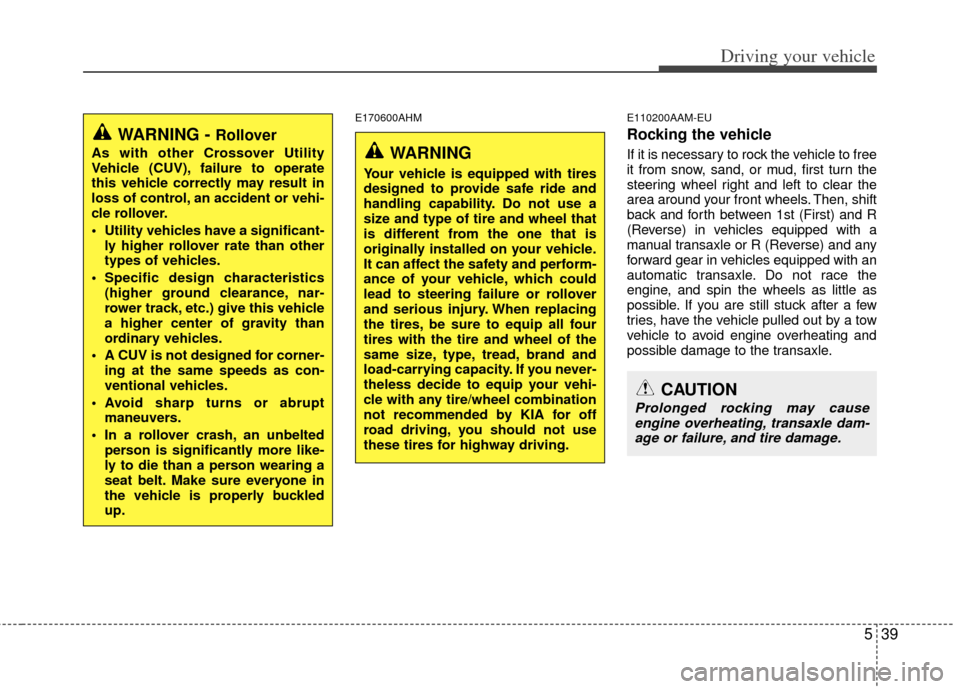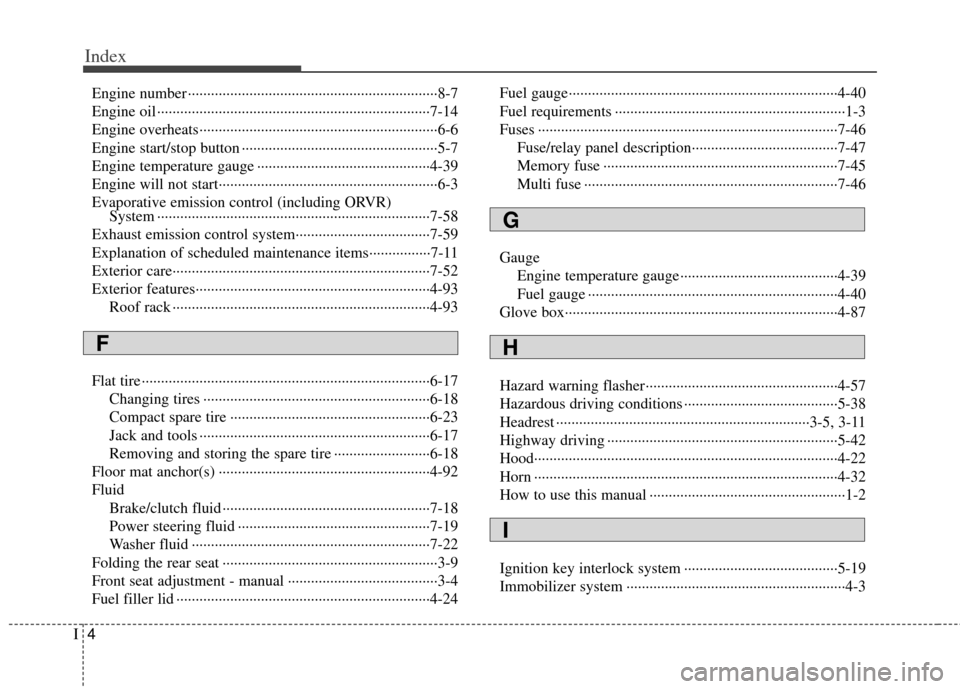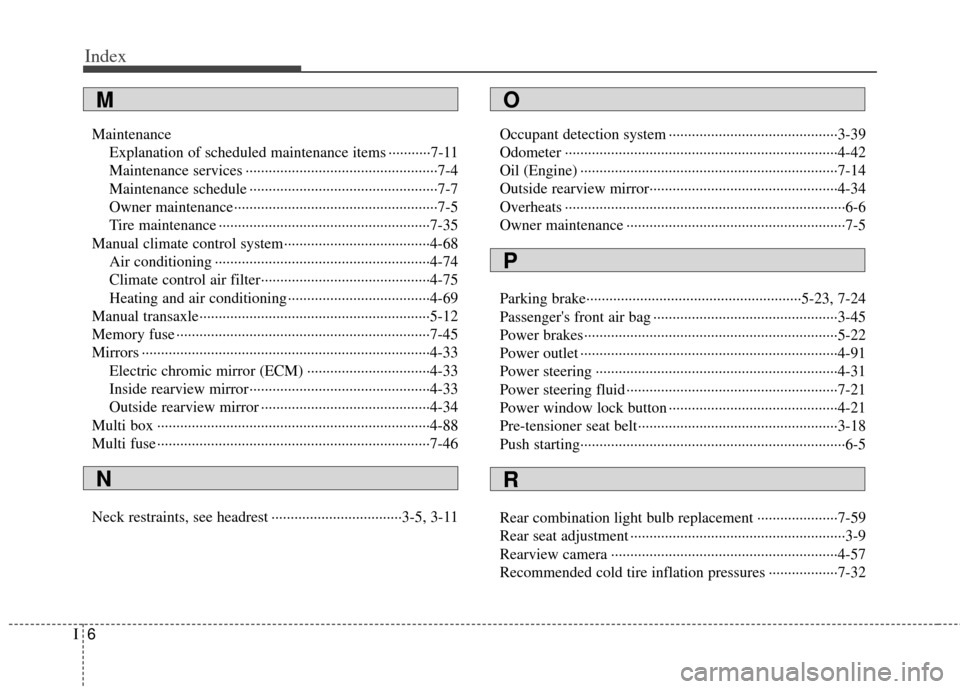2011 KIA Soul engine overheat
[x] Cancel search: engine overheatPage 240 of 356

539
Driving your vehicle
E170600AHME110200AAM-EU
Rocking the vehicle
If it is necessary to rock the vehicle to free
it from snow, sand, or mud, first turn the
steering wheel right and left to clear the
area around your front wheels. Then, shift
back and forth between 1st (First) and R
(Reverse) in vehicles equipped with a
manual transaxle or R (Reverse) and any
forward gear in vehicles equipped with an
automatic transaxle. Do not race the
engine, and spin the wheels as little as
possible. If you are still stuck after a few
tries, have the vehicle pulled out by a tow
vehicle to avoid engine overheating and
possible damage to the transaxle.
CAUTION
Prolonged rocking may cause
engine overheating, transaxle dam- age or failure, and tire damage.
WARNING
Your vehicle is equipped with tires
designed to provide safe ride and
handling capability. Do not use a
size and type of tire and wheel that
is different from the one that is
originally installed on your vehicle.
It can affect the safety and perform-
ance of your vehicle, which could
lead to steering failure or rollover
and serious injury. When replacing
the tires, be sure to equip all four
tires with the tire and wheel of the
same size, type, tread, brand and
load-carrying capacity. If you never-
theless decide to equip your vehi-
cle with any tire/wheel combination
not recommended by KIA for off
road driving, you should not use
these tires for highway driving.
WARNING - Rollover
As with other Crossover Utility
Vehicle (CUV), failure to operate
this vehicle correctly may result in
loss of control, an accident or vehi-
cle rollover.
Utility vehicles have a significant- ly higher rollover rate than other
types of vehicles.
Specific design characteristics (higher ground clearance, nar-
rower track, etc.) give this vehicle
a higher center of gravity than
ordinary vehicles.
A CUV is not designed for corner- ing at the same speeds as con-
ventional vehicles.
Avoid sharp turns or abrupt maneuvers.
In a rollover crash, an unbelted person is significantly more like-
ly to die than a person wearing a
seat belt. Make sure everyone in
the vehicle is properly buckled
up.
Page 243 of 356

Driving your vehicle
42
5
E110700AHM
Highway driving
Tires
Adjust the tire inflation pressures to
specification. Low tire inflation pressures
will result in overheating and possible
failure of the tires.
Avoid using worn or damaged tires which
may result in reduced traction or tire fail-
ure.
✽ ✽
NOTICE
Never exceed the maximum tire inflation
pressure shown on the tires.
Fuel, engine coolant and engine oil
High speed travel consumes more fuel
than urban motoring. Do not forget to
check both the engine coolant and
engine oil.
Drive belt
A loose or damaged drive belt may result
in overheating of the engine.
WARNING
Underinflated or overinflated
tires can cause poor handling,
loss of vehicle control, and sud-
den tire failure leading to acci-
dents, injuries, and even death.
Always check tires for proper
inflation before driving. For prop-
er tire pressures, refer to “Tires
and wheels” in section 8.
Driving on tires with no or insuffi- cient tread is dangerous. Worn-
out tires can result in loss of
vehicle control, collisions, injury,
and even death. Worn-out tires
should be replaced as soon as
possible and should never be
used for driving. Always check
the tire tread before driving your
car. For further information and
tread limits, refer to “Tires and
wheels” in section 7.
Page 252 of 356

6
Road warning / 6-2
In case of an emergency while driving / 6-2
If the engine will not start / 6-3
Emergency starting / 6-4
If the engine overheats / 6-6
Tire pressure monitoring system (TPMS) / 6-7
If you have a flat tire / 6-17
Towing / 6-25
What to do in an emergency
Page 256 of 356

65
What to do in an emergency
F040101ASA
Jump starting procedure
1. Make sure the booster battery is 12-volt and that its negative terminal is
grounded.
2. If the booster battery is in another vehicle, do not allow the vehicles to
come in contact.
3. Turn off all unnecessary electrical loads.
4. Connect the jumper cables in the exact sequence shown in the illustration.
First connect one end of a jumper
cable to the positive terminal of the
discharged battery (1), then connect
the other end to the positive terminal
of the booster battery (2).
Proceed to connect one end of the
other jumper cable to the negative ter-
minal of the booster battery (3), then
the other end to a solid, stationary,
metallic point (for example, the engine
lifting bracket) away from the battery
(4). Do not connect it to or near any
part that moves when the engine is
cranked. Do not allow the jumper cables to con-
tact anything except the correct battery
terminals or the correct ground. Do not
lean over the battery when making
connections.
5. Start the engine of the vehicle with the booster battery and let it run at 2,000
rpm, then start the engine of the vehi-
cle with the discharged battery.
If the cause of your battery discharging isnot apparent, you should have your vehi-cle checked by an authorized KIA dealer.
F040200AAM-EU
Push-starting
Vehicles equipped with automatic
transaxle and manual transaxle vehicles
equipped with clutch lock system cannot
be push-started.
Follow the directions in this section for
jump-starting.
CAUTION- Battery cables
Do not connect the jumper cablefrom the negative terminal of thebooster battery to the negative ter- minal of the discharged battery.This can cause the discharged bat-tery to overheat and crack, releas-ing battery acid.
WARNING
Never tow a vehicle to start it
because the sudden surge forward
when the engine starts could cause
a collision with the tow vehicle.
Page 257 of 356

What to do in an emergency
66
IF THE ENGINE OVERHEATS
F050000AAM
If your temperature gauge indicates over-
heating, you experience a loss of power,
or hear loud pinging or knocking, the
engine will probably be too hot. If this
happens, you should:
1. Pull off the road and stop as soon as itis safe to do so.
2. Place the shift lever in P (Park, auto- matic transaxle) or Neutral (manual
transaxle) and set the parking brake. If
the air conditioning is on, turn it off.
3. If engine coolant is running out under the vehicle or steam is coming out
from underneath the hood, stop the
engine. Do not open the hood until the
coolant has stopped running or the
steaming has stopped. If there is no
visible loss of engine coolant and no
steam, leave the engine running and
check to be sure the engine cooling
fan is operating. If the fan is not run-
ning, turn the engine off. 4. Check to see if the water pump drive
belt is missing. If it is not missing,
check to see that it is tight. If the drive
belt seems to be satisfactory, check for
coolant leaking from the radiator,
hoses or under the vehicle. (If the air
conditioning had been in use, it is nor-
mal for cold water to be draining from
it when you stop).
5. If the water pump drive belt is broken or engine coolant is leaking out, stop
the engine immediately and call the
nearest authorized KIA dealer for
assistance. 6. If you cannot find the cause of the
overheating, wait until the engine tem-
perature has returned to normal. Then,
if coolant has been lost, carefully add
coolant to the reservoir to bring the
fluid level in the reservoir up to the
halfway mark.
7. Proceed with caution, keeping alert for further signs of overheating. If over-
heating happens again, call an author-
ized KIA dealer for assistance.
WARNING
While the engine is running, keep
hair, hands and clothing away from
moving parts such as the fan and
drive belts to prevent injury.
WARNING
Do not remove the radiator cap
when the engine is hot. This may
result in coolant being blown out of
the opening and cause serious
burns.
CAUTION
Serious loss of coolant indicates
there is a leak in the cooling systemand this should be checked as soonas possible by an authorized KIAdealer.
Page 351 of 356

Index
4I
Engine number ··················\
··················\
··················\
···········8-7
Engine oil ··················\
··················\
··················\
·················7-14\
Engine overheats··················\
··················\
··················\
········6-6
Engine start/stop button ··················\
··················\
···············5-7
Engine temperature gauge ··················\
··················\
·········4-39
Engine will not start··················\
··················\
··················\
···6-3
Evaporative emission control (including ORVR) System ··················\
··················\
··················\
·················7-58\
Exhaust emission control system··················\
·················7-59\
Explanation of scheduled maintenance items················7-11
Exterior care··················\
··················\
··················\
·············7-52
Exterior features··················\
··················\
··················\
·······4-93 Roof rack ··················\
··················\
··················\
·············4-93
Flat tire ··················\
··················\
··················\
··················\
···6-17 Changing tires ··················\
··················\
··················\
·····6-18
Compact spare tire ··················\
··················\
················6-23
Jack and tools ··················\
··················\
··················\
······6-17
Removing and storing the spare tire ··················\
·······6-18
Floor mat anchor(s) ··················\
··················\
··················\
·4-92
Fluid Brake/clutch fluid ··················\
··················\
··················\
7-18
Power steering fluid ··················\
··················\
··············7-19
Washer fluid ··················\
··················\
··················\
········7-22
Folding the rear seat ··················\
··················\
··················\
··3-9
Front seat adjustment - manual ··················\
··················\
···3-4
Fuel filler lid ··················\
··················\
··················\
············4-24 Fuel gauge··················\
··················\
··················\
················4-40
Fuel requirements ··················\
··················\
··················\
······1-3
Fuses ··················\
··················\
··················\
··················\
······7-46
Fuse/relay panel description··················\
··················\
··7-47
Memory fuse ··················\
··················\
··················\
·······7-45
Multi fuse ··················\
··················\
··················\
············7-46
Gauge Engine temperature gauge··················\
··················\
·····4-39
Fuel gauge ··················\
··················\
··················\
···········4-40
Glove box··················\
··················\
··················\
·················4-87\
Hazard warning flasher··················\
··················\
··············4-57
Hazardous driving conditions ··················\
··················\
····5-38
Headrest ··················\
··················\
··················\
············3-5, 3-11
Highway driving ··················\
··················\
··················\
······5-42
Hood··················\
··················\
··················\
··················\
·······4-22
Horn ··················\
··················\
··················\
··················\
·······4-32
How to use this manual ··················\
··················\
···············1-2
Ignition key interlock system ··················\
··················\
····5-19
Immobilizer system ··················\
··················\
··················\
···4-3
F
G
H
I
Page 353 of 356

Index
6I
MaintenanceExplanation of scheduled maintenance items ···········7-11
Maintenance services ··················\
··················\
··············7-4
Maintenance schedule ··················\
··················\
·············7-7
Owner maintenance··················\
··················\
·················7-5
Tire maintenance ··················\
··················\
··················\
·7-35
Manual climate control system··················\
··················\
··4-68 Air conditioning ··················\
··················\
··················\
··4-74
Climate control air filter··················\
··················\
········4-75
Heating and air conditioning··················\
··················\
·4-69
Manual transaxle··················\
··················\
··················\
······5-12
Memory fuse ··················\
··················\
··················\
············7-45
Mirrors ··················\
··················\
··················\
··················\
···4-33 Electric chromic mirror (ECM) ··················\
··············4-33
Inside rearview mirror··················\
··················\
···········4-33
Outside rearview mirror ··················\
··················\
········4-34
Multi box ··················\
··················\
··················\
·················4-88\
Multi fuse ··················\
··················\
··················\
·················7-46\
Neck restraints, see headrest ··················\
················3-5, 3-1\
1 Occupant detection system ··················\
··················\
········3-39
Odometer ··················\
··················\
··················\
·················4-42\
Oil (Engine) ··················\
··················\
··················\
·············7-14
Outside rearview mirror··················\
··················\
·············4-34
Overheats ··················\
··················\
··················\
··················\
·6-6
Owner maintenance ··················\
··················\
··················\
···7-5
Parking brake··················\
··················\
··················\
··5-23, 7-24
Passenger's front air bag ··················\
··················\
············3-45
Power brakes··················\
··················\
··················\
············5-22
Power outlet ··················\
··················\
··················\
·············4-91
Power steering ··················\
··················\
··················\
·········4-31
Power steering fluid ··················\
··················\
··················\
·7-21
Power window lock button ··················\
··················\
········4-21
Pre-tensioner seat belt··················\
··················\
················3-18
Push starting··················\
··················\
··················\
···············6-5
Rear combination light bulb replacement ··················\
···7-59
Rear seat adjustment ··················\
··················\
··················\
··3-9
Rearview camera ··················\
··················\
··················\
·····4-57
Recommended cold tire inflation pressures ··················\
7-32
O
P
R
M
N